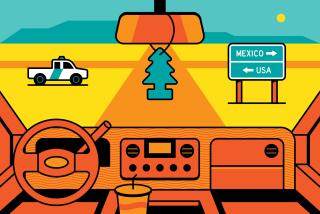North of the Border : Mexico Honors Diversity With ‘Mexican Faces in California’ Exhibit
- Share via
MEXICO CITY — Not only gringos rely on stereotypes. Many Mexicans have long viewed their 20 million (or so) brethren in the United States as a mass of poor, uneducated peasants knee-deep in the Rio Grande. The Mexican government--among the worst offenders--for too many years failed to distinguish between Mexican-Americans and undocumented immigrants, and dismissed all of them as politically powerless recent arrivals on U.S. soil.
Now, in a turnabout, the government is sponsoring a photographic exhibit that attempts to show Mexicans in the United States and Mexican-Americans as a heterogeneous population integrated into American life and history--war veterans and Cub Scouts, zoot-suiters, farm laborers and factory workers. They are Americanized, as the exhibit makes clear, but with clear links to Mexican culture.
“Mexican Faces in California,” 124 eclectic photographs on display at the National Museum of Anthropology and History through Jan. 8, is sponsored by the Foreign Ministry’s 2-year-old Program for Mexican Communities Abroad.
“Artists have been way ahead of us,” said Roger Diaz de Cossio, director of the Foreign Ministry program and coordinator of the exhibit. “Photographers and painters have had contact. (Rufino) Tamayo and (Francisco) Toledo have had influence there, (Edward) Weston had influence here. There has been lots of back and forth--legally and illegally.”
“We wanted a vision of diversity of Mexican-Americans,” added Esther Schumacher, director of cultural programming. “They have been in the United States. They didn’t just arrive.”
The exhibition is timed to coincide with the awarding of Mexico’s highest honor, the Mexican Order of the Aztec Eagle, to three Mexican-Americans: Los Angeles County Supervisor Gloria Molina, Texas politician and recent Clinton Cabinet-appointee Henry Cisneros and Raul Yzaguirre, director of the National Council of La Raza. For the third year in a row, President Carlos Salinas de Gortari will present the award to Mexican-Americans who the government believes have defended the culture and human rights of Mexicans and Mexican-Americans in the United States.
The show is actually three exhibits. The first, titled “Shadows of Los Angeles,” includes 55 historical photographs assembled by the Friends of Photography of the Los Angeles Public Library. Under the direction of Carolyn Kozo, the images were collected from archives and family albums to depict 100 years of Mexican-American life, from the 1860s to 1960s.
In some ways, this is the most striking segment of the show, as it goes beyond most stereotypes. Among the earliest black-and-white images are the Lopez Bros. grocery store in Boyle Heights in 1916 and a Mexican-American soldier in full uniform--including knee-high boots--in 1921.
Mexican-Americans are pictured at a 1939 Mexican Independence Day celebration in Los Angeles, posing in zoot suits (1944) and at work--laughing women in work clothes with hair tied back--outside the Southern California Fish Corp. in San Pedro (1947). In the 1950s, they are Cub Scouts, members of a bowling league and college graduates. They are delivering the first Spanish-language television transmission of the Rose Parade in 1952. In 1968, a young Cesar Chavez demonstrates for fair wages.
The second segment, “Vision of Ourselves,” is a collection of images from 10 Mexican and Chicano photographers organized by Los Angeles photographer Domingo A. Rodriguez to show what he calls “conflicts in the process of acculturation, the politics of assimilation, and changes that the community of Mexican origin suffers in the United States.”
Here we see Max Aguilera Hellweg’s photographs of immigrants crossing the border and of la migra --agents of the Department of Immigration and Naturalization. We also see very personal photos depicting the complexities of barrio life. Ricardo Valverde touchingly depicts his sick mother and his parents watching television; Jose Galvez captures an older homeboy almost ritually tying a bandanna around the head of a young protege, and a tattooed cholo kissing his girlfriend. In a photograph titled “Assimilation,” Rodriguez shows a woman, worried eyes cast down, arms folded, leaning against a peeling wall of graffiti.
The final segment, “Work in the Fields,” is a series documenting the conditions in which migrant workers still live and labor in the San Joaquin Valley. They were shot by California photographer Genaro Molina for the Sacramento Bee in 1991.
Among his more striking photos are one of a girl bathing in a dirty irrigation ditch next to her mother washing clothes, and another of a father and daughter suffering from pesticide-induced sores. Yet another is a close-up look at hard labor--a woman’s cracked hands, knuckles wrapped in electrical tape, around a bucket of just-picked olives.
For the close of “Mexican Faces in California,” the Mexican government plans to bring several of the American photographers to Mexico for a workshop with their Mexican counterparts.
“The objective,” said Diaz Cossio, “is continuing closeness. It’s to better relations between Mexicans in Mexico and Mexicans in the United States.”
More to Read
Sign up for Essential California
The most important California stories and recommendations in your inbox every morning.
You may occasionally receive promotional content from the Los Angeles Times.










